TOYOTA LAND CRUISER 2012 Owners Manual
Manufacturer: TOYOTA, Model Year: 2012, Model line: LAND CRUISER, Model: TOYOTA LAND CRUISER 2012Pages: 692, PDF Size: 29.3 MB
Page 291 of 692
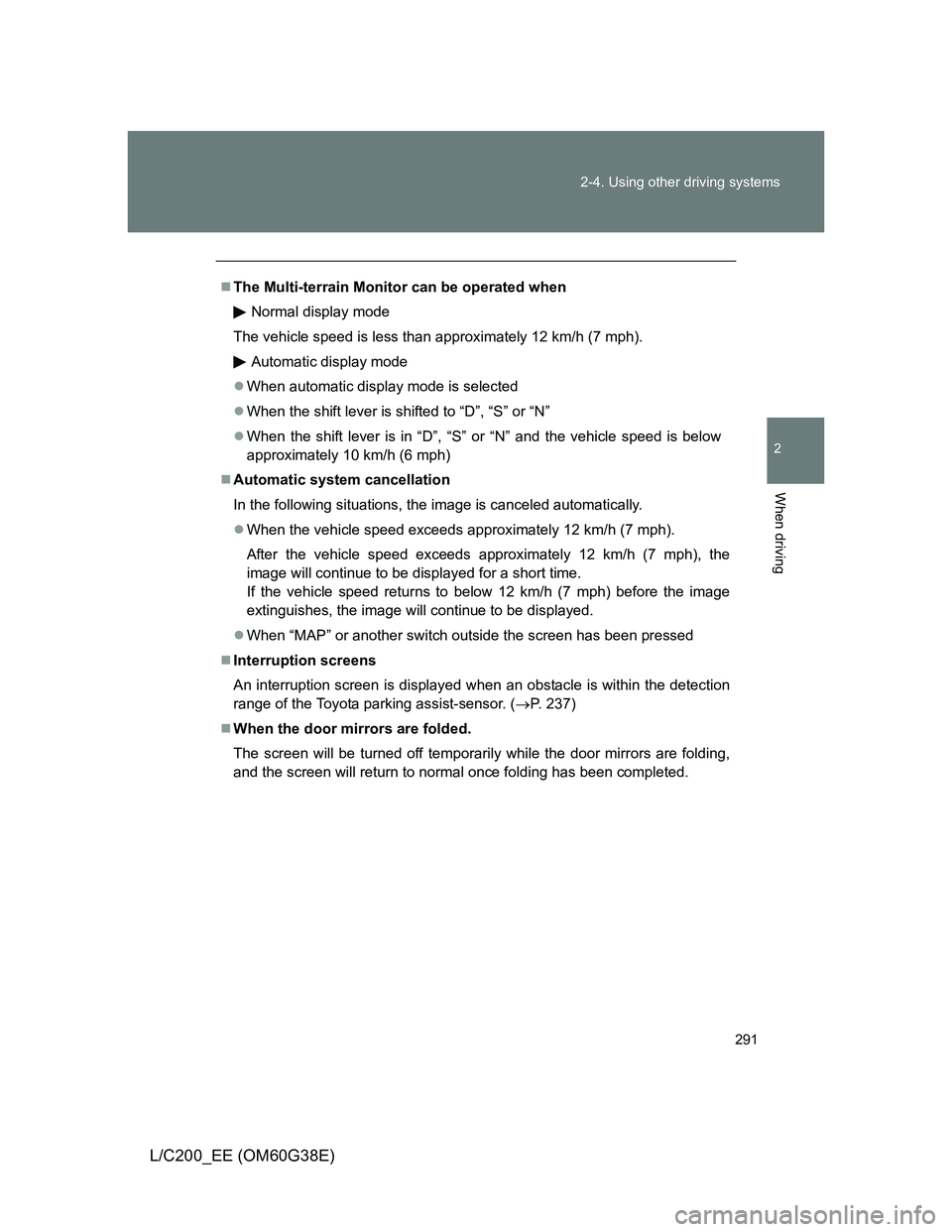
291 2-4. Using other driving systems
2
When driving
L/C200_EE (OM60G38E)
The Multi-terrain Monitor can be operated when
Normal display mode
The vehicle speed is less than approximately 12 km/h (7 mph).
Automatic display mode
When automatic display mode is selected
When the shift lever is shifted to “D”, “S” or “N”
When the shift lever is in “D”, “S” or “N” and the vehicle speed is below
approximately 10 km/h (6 mph)
Automatic system cancellation
In the following situations, the image is canceled automatically.
When the vehicle speed exceeds approximately 12 km/h (7 mph).
After the vehicle speed exceeds approximately 12 km/h (7 mph), the
image will continue to be displayed for a short time.
If the vehicle speed returns to below 12 km/h (7 mph) before the image
extinguishes, the image will continue to be displayed.
When “MAP” or another switch outside the screen has been pressed
Interruption screens
An interruption screen is displayed when an obstacle is within the detection
range of the Toyota parking assist-sensor. (P. 237)
When the door mirrors are folded.
The screen will be turned off temporarily while the door mirrors are folding,
and the screen will return to normal once folding has been completed.
Page 292 of 692
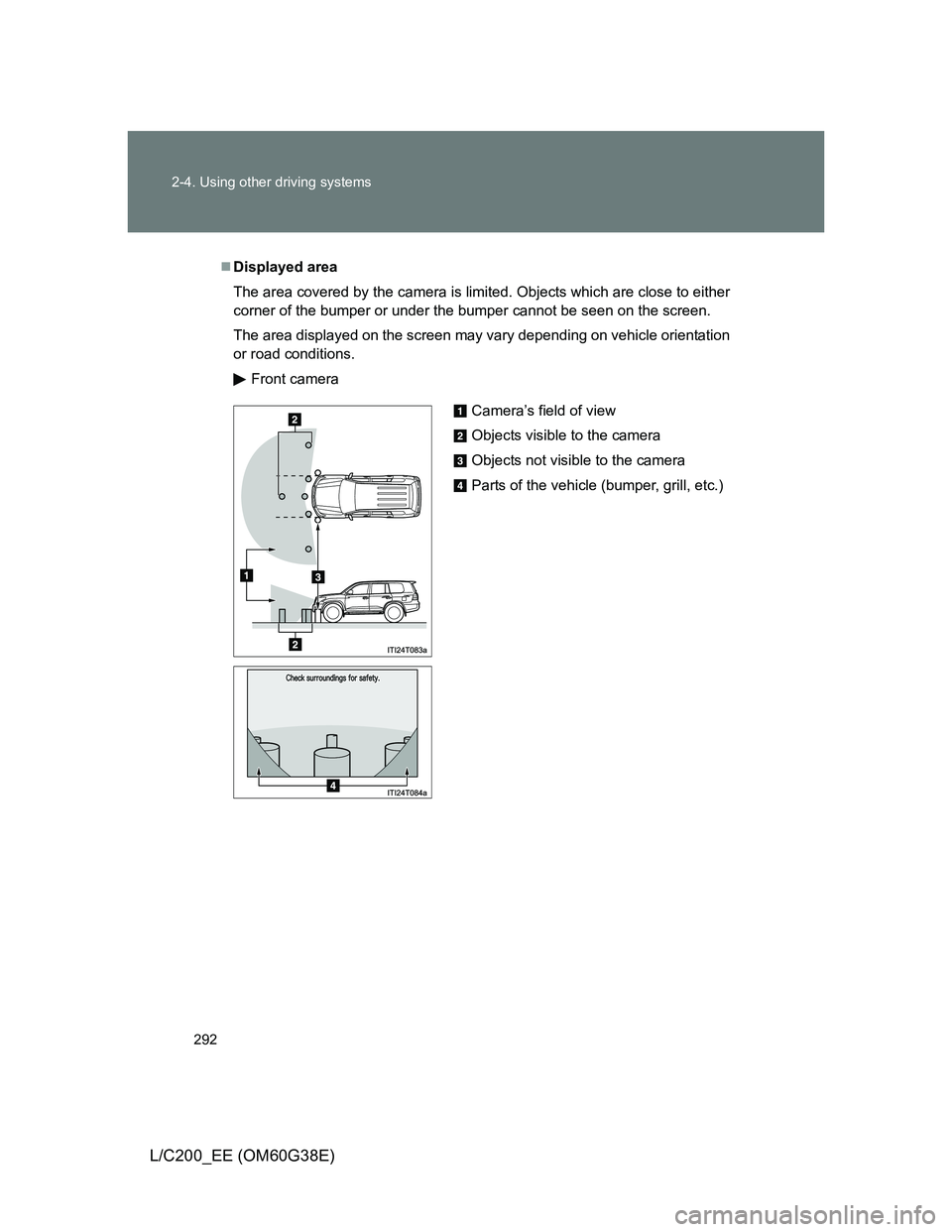
292 2-4. Using other driving systems
L/C200_EE (OM60G38E)
Displayed area
The area covered by the camera is limited. Objects which are close to either
corner of the bumper or under the bumper cannot be seen on the screen.
The area displayed on the screen may vary depending on vehicle orientation
or road conditions.
Front camera
Camera’s field of view
Objects visible to the camera
Objects not visible to the camera
Parts of the vehicle (bumper, grill, etc.)
Page 293 of 692
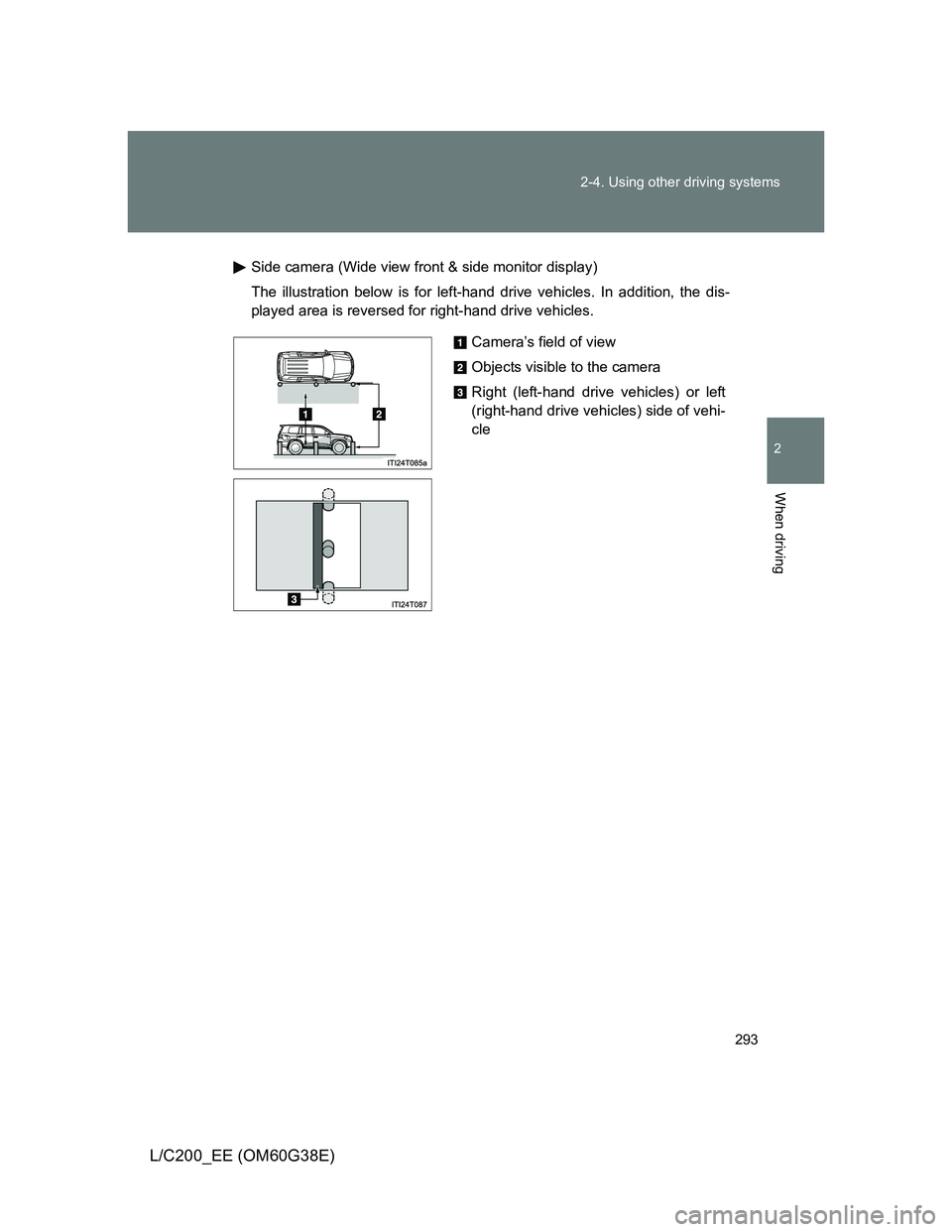
293 2-4. Using other driving systems
2
When driving
L/C200_EE (OM60G38E)
Side camera (Wide view front & side monitor display)
The illustration below is for left-hand drive vehicles. In addition, the dis-
played area is reversed for right-hand drive vehicles.
Camera’s field of view
Objects visible to the camera
Right (left-hand drive vehicles) or left
(right-hand drive vehicles) side of vehi-
cle
Page 294 of 692
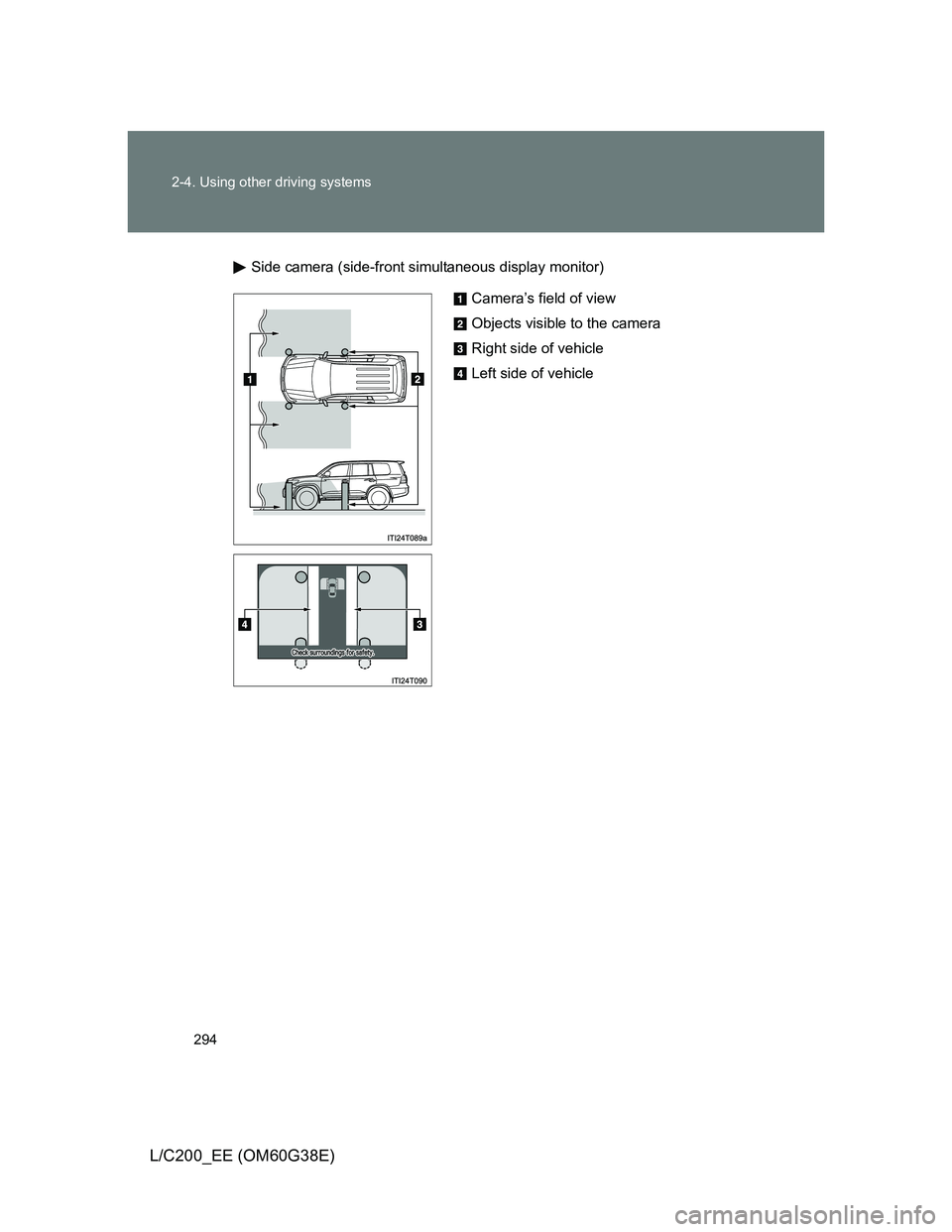
294 2-4. Using other driving systems
L/C200_EE (OM60G38E)
Side camera (side-front simultaneous display monitor)
Camera’s field of view
Objects visible to the camera
Right side of vehicle
Left side of vehicle
Page 295 of 692
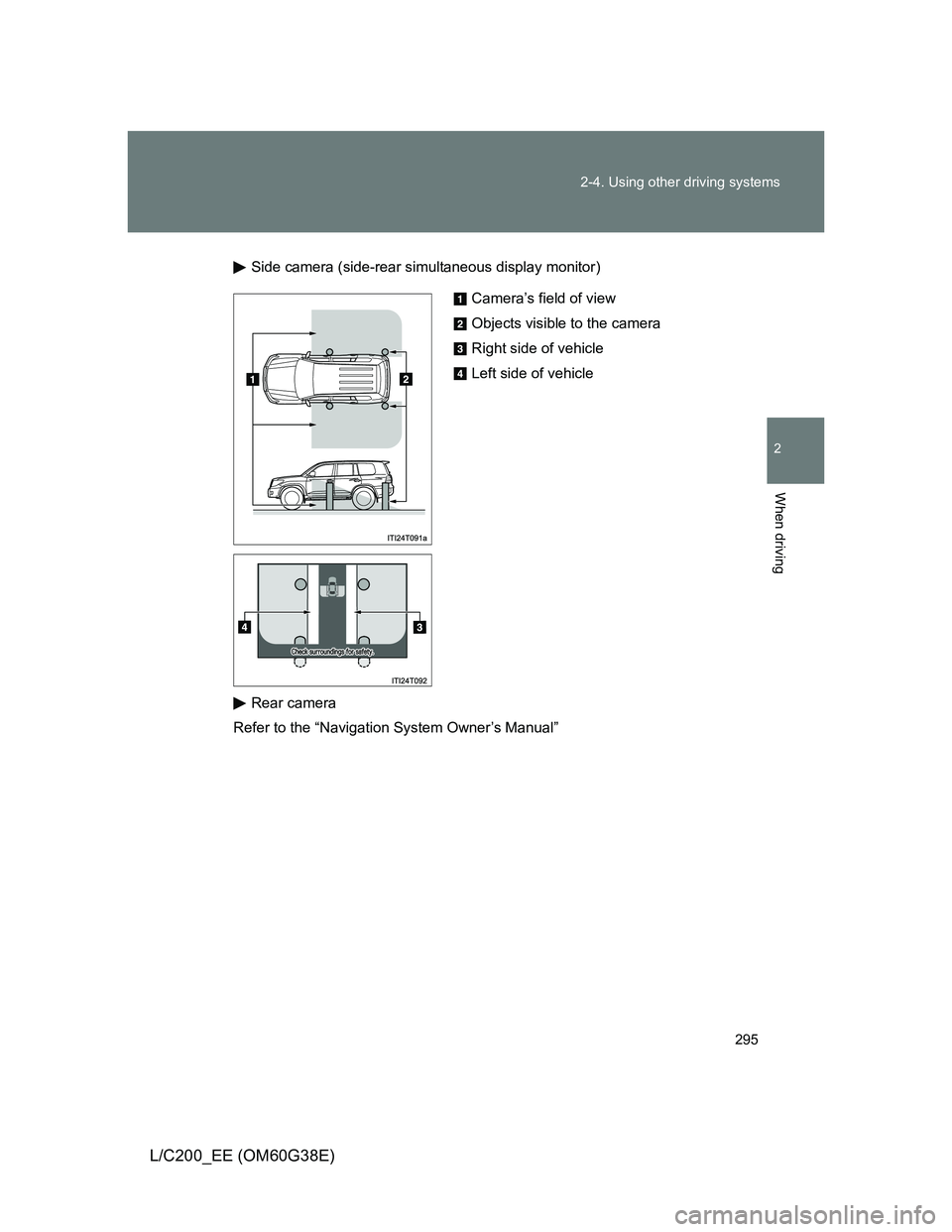
295 2-4. Using other driving systems
2
When driving
L/C200_EE (OM60G38E)
Side camera (side-rear simultaneous display monitor)
Rear camera
Refer to the “Navigation System Owner’s Manual”
Camera’s field of view
Objects visible to the camera
Right side of vehicle
Left side of vehicle
Page 296 of 692
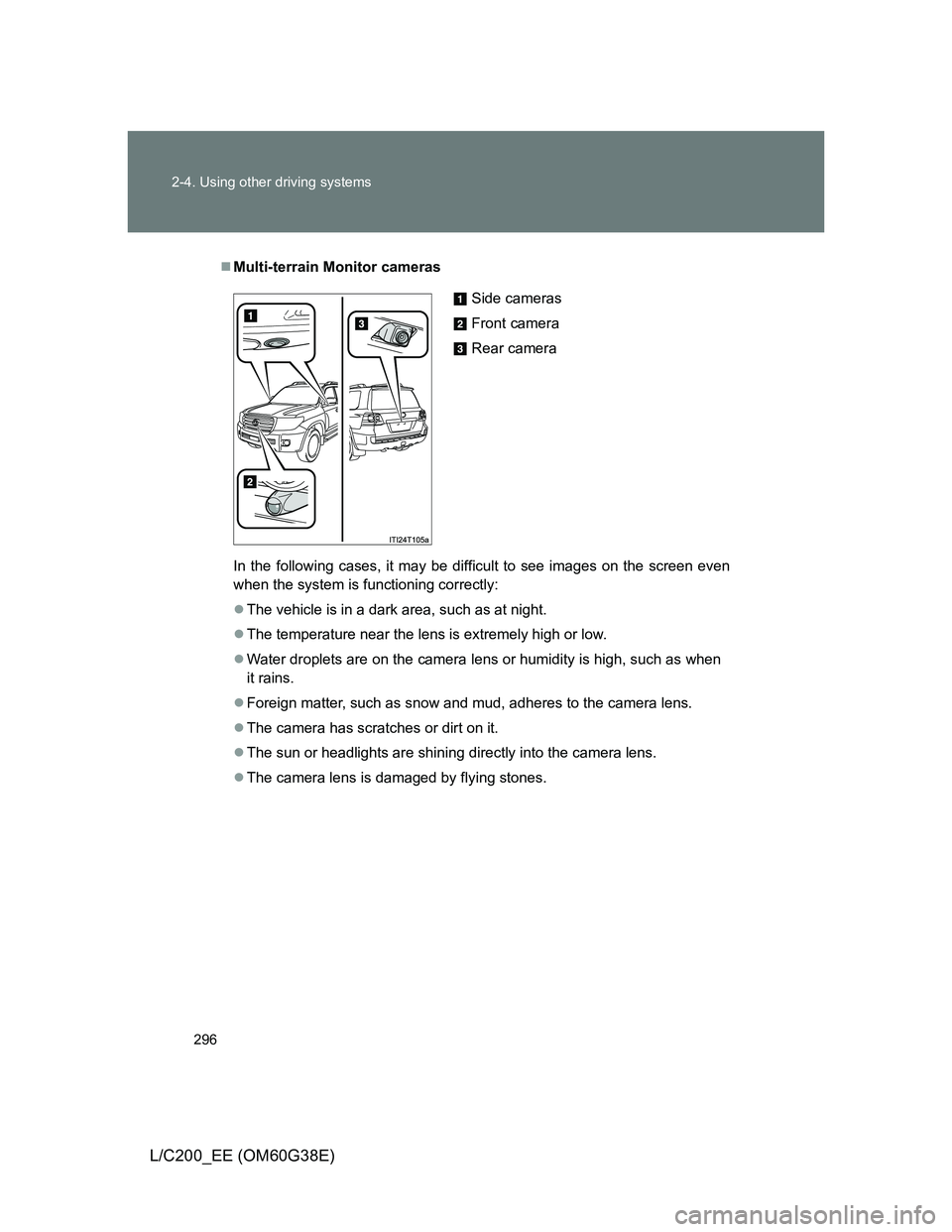
296 2-4. Using other driving systems
L/C200_EE (OM60G38E)
Multi-terrain Monitor cameras
In the following cases, it may be difficult to see images on the screen even
when the system is functioning correctly:
The vehicle is in a dark area, such as at night.
The temperature near the lens is extremely high or low.
Water droplets are on the camera lens or humidity is high, such as when
it rains.
Foreign matter, such as snow and mud, adheres to the camera lens.
The camera has scratches or dirt on it.
The sun or headlights are shining directly into the camera lens.
The camera lens is damaged by flying stones.
Side cameras
Front camera
Rear camera
Page 297 of 692
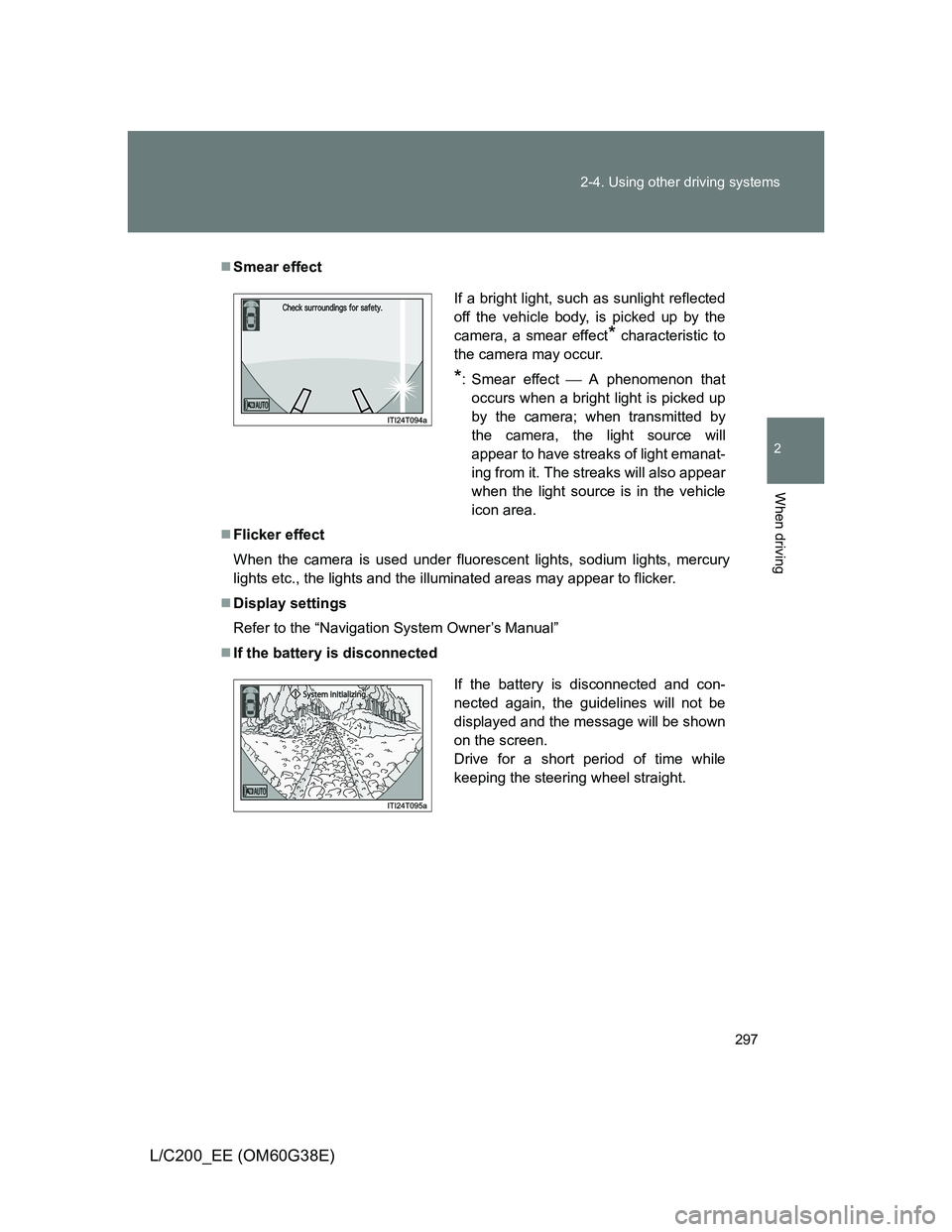
297 2-4. Using other driving systems
2
When driving
L/C200_EE (OM60G38E)
Smear effect
Flicker effect
When the camera is used under fluorescent lights, sodium lights, mercury
lights etc., the lights and the illuminated areas may appear to flicker.
Display settings
Refer to the “Navigation System Owner’s Manual”
If the battery is disconnected
If a bright light, such as sunlight reflected
off the vehicle body, is picked up by the
camera, a smear effect
* characteristic to
the camera may occur.
*: Smear effectA phenomenon that
occurs when a bright light is picked up
by the camera; when transmitted by
the camera, the light source will
appear to have streaks of light emanat-
ing from it. The streaks will also appear
when the light source is in the vehicle
icon area.
If the battery is disconnected and con-
nected again, the guidelines will not be
displayed and the message will be shown
on the screen.
Drive for a short period of time while
keeping the steering wheel straight.
Page 298 of 692
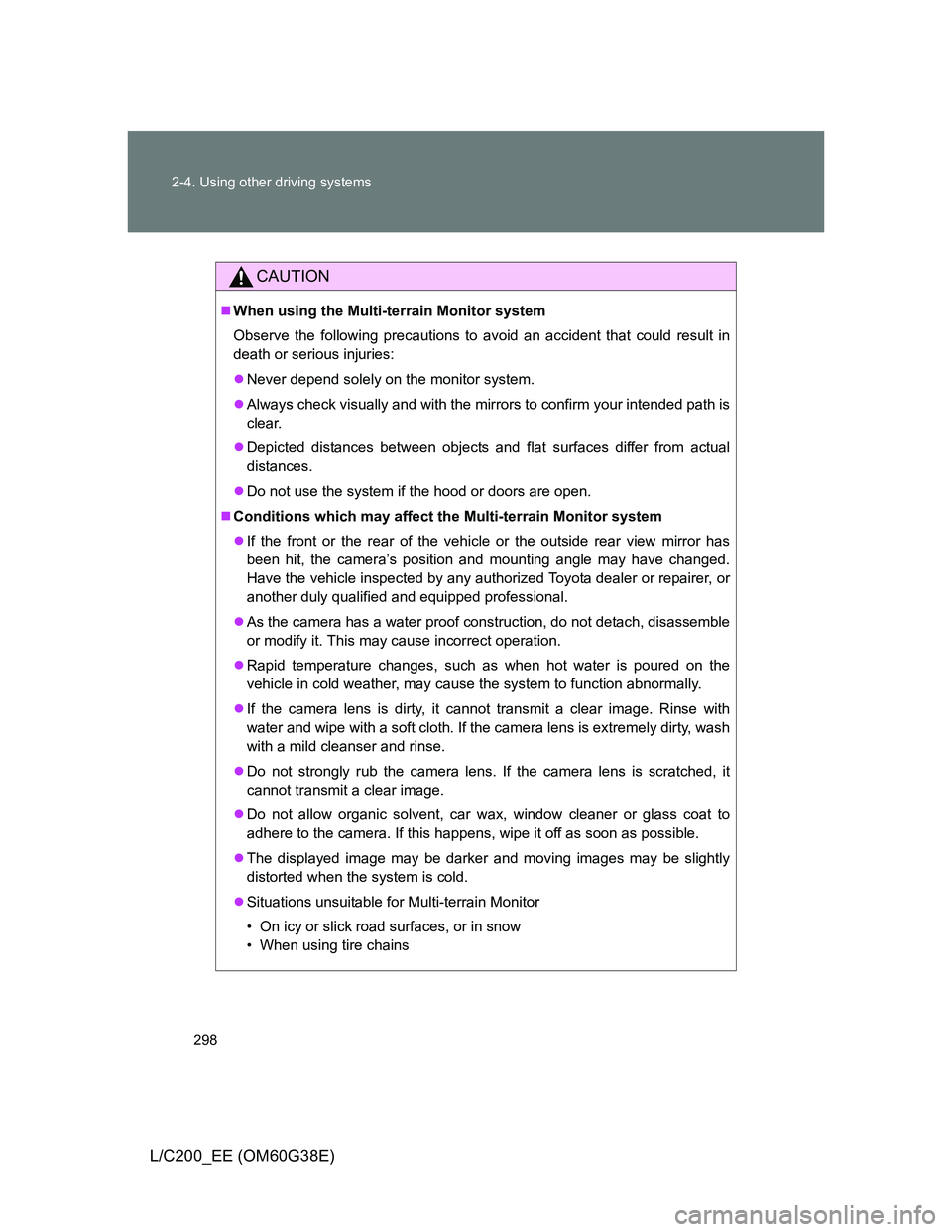
298 2-4. Using other driving systems
L/C200_EE (OM60G38E)
CAUTION
When using the Multi-terrain Monitor system
Observe the following precautions to avoid an accident that could result in
death or serious injuries:
Never depend solely on the monitor system.
Always check visually and with the mirrors to confirm your intended path is
clear.
Depicted distances between objects and flat surfaces differ from actual
distances.
Do not use the system if the hood or doors are open.
Conditions which may affect the Multi-terrain Monitor system
If the front or the rear of the vehicle or the outside rear view mirror has
been hit, the camera’s position and mounting angle may have changed.
Have the vehicle inspected by any authorized Toyota dealer or repairer, or
another duly qualified and equipped professional.
As the camera has a water proof construction, do not detach, disassemble
or modify it. This may cause incorrect operation.
Rapid temperature changes, such as when hot water is poured on the
vehicle in cold weather, may cause the system to function abnormally.
If the camera lens is dirty, it cannot transmit a clear image. Rinse with
water and wipe with a soft cloth. If the camera lens is extremely dirty, wash
with a mild cleanser and rinse.
Do not strongly rub the camera lens. If the camera lens is scratched, it
cannot transmit a clear image.
Do not allow organic solvent, car wax, window cleaner or glass coat to
adhere to the camera. If this happens, wipe it off as soon as possible.
The displayed image may be darker and moving images may be slightly
distorted when the system is cold.
Situations unsuitable for Multi-terrain Monitor
• On icy or slick road surfaces, or in snow
• When using tire chains
Page 299 of 692
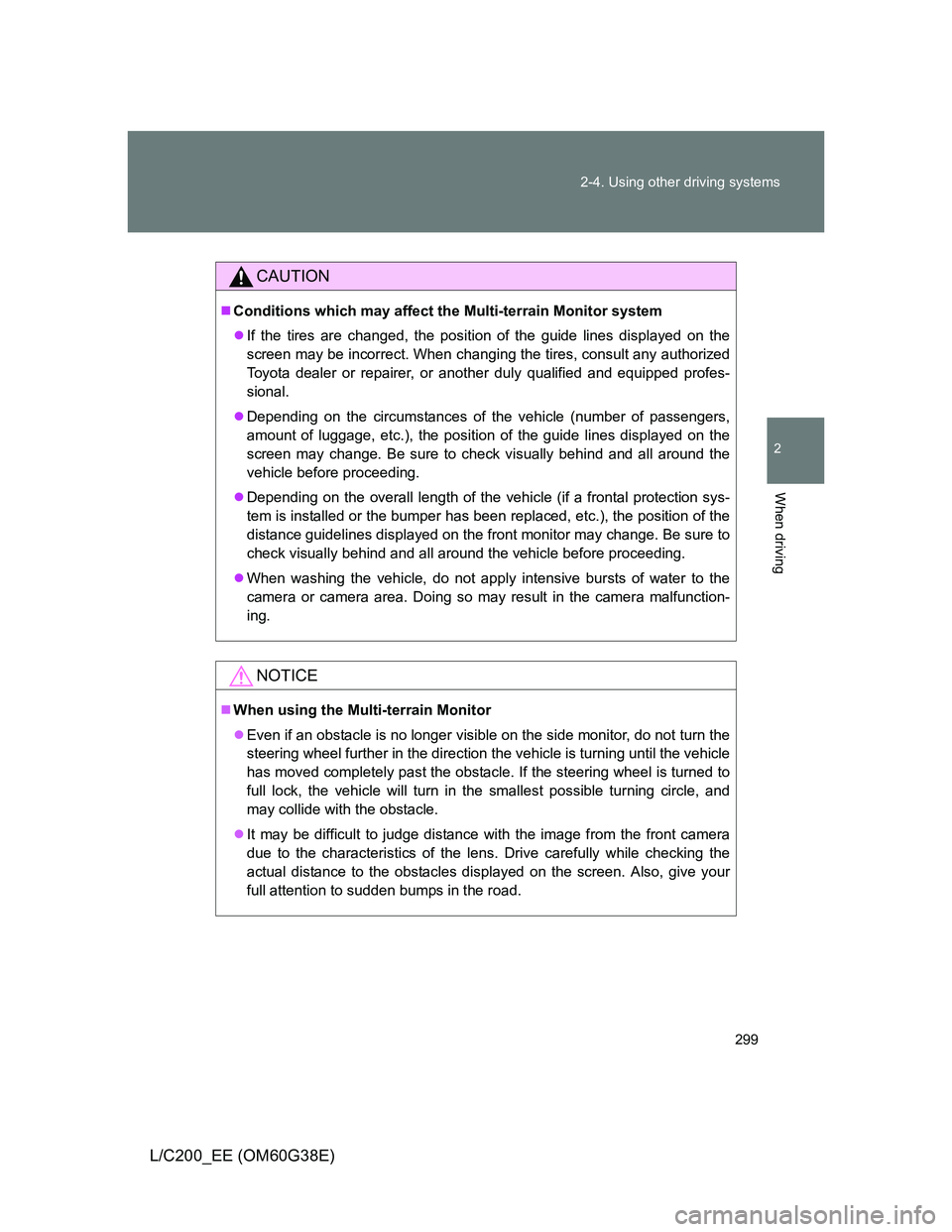
299 2-4. Using other driving systems
2
When driving
L/C200_EE (OM60G38E)
CAUTION
Conditions which may affect the Multi-terrain Monitor system
If the tires are changed, the position of the guide lines displayed on the
screen may be incorrect. When changing the tires, consult any authorized
Toyota dealer or repairer, or another duly qualified and equipped profes-
sional.
Depending on the circumstances of the vehicle (number of passengers,
amount of luggage, etc.), the position of the guide lines displayed on the
screen may change. Be sure to check visually behind and all around the
vehicle before proceeding.
Depending on the overall length of the vehicle (if a frontal protection sys-
tem is installed or the bumper has been replaced, etc.), the position of the
distance guidelines displayed on the front monitor may change. Be sure to
check visually behind and all around the vehicle before proceeding.
When washing the vehicle, do not apply intensive bursts of water to the
camera or camera area. Doing so may result in the camera malfunction-
ing.
NOTICE
When using the Multi-terrain Monitor
Even if an obstacle is no longer visible on the side monitor, do not turn the
steering wheel further in the direction the vehicle is turning until the vehicle
has moved completely past the obstacle. If the steering wheel is turned to
full lock, the vehicle will turn in the smallest possible turning circle, and
may collide with the obstacle.
It may be difficult to judge distance with the image from the front camera
due to the characteristics of the lens. Drive carefully while checking the
actual distance to the obstacles displayed on the screen. Also, give your
full attention to sudden bumps in the road.
Page 300 of 692
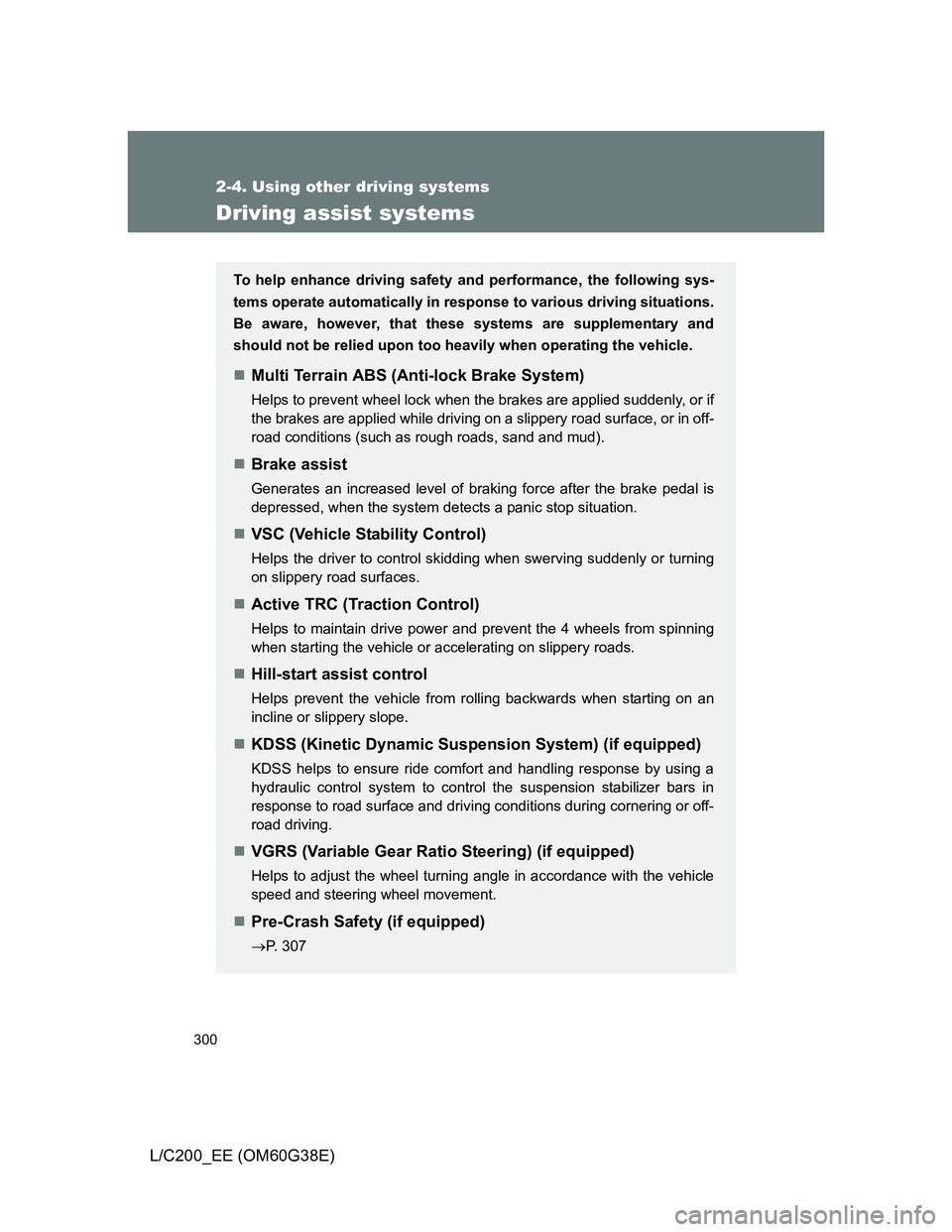
300
2-4. Using other driving systems
L/C200_EE (OM60G38E)
Driving assist systems
To help enhance driving safety and performance, the following sys-
tems operate automatically in response to various driving situations.
Be aware, however, that these systems are supplementary and
should not be relied upon too heavily when operating the vehicle.
Multi Terrain ABS (Anti-lock Brake System)
Helps to prevent wheel lock when the brakes are applied suddenly, or if
the brakes are applied while driving on a slippery road surface, or in off-
road conditions (such as rough roads, sand and mud).
Brake assist
Generates an increased level of braking force after the brake pedal is
depressed, when the system detects a panic stop situation.
VSC (Vehicle Stability Control)
Helps the driver to control skidding when swerving suddenly or turning
on slippery road surfaces.
Active TRC (Traction Control)
Helps to maintain drive power and prevent the 4 wheels from spinning
when starting the vehicle or accelerating on slippery roads.
Hill-start assist control
Helps prevent the vehicle from rolling backwards when starting on an
incline or slippery slope.
KDSS (Kinetic Dynamic Suspension System) (if equipped)
KDSS helps to ensure ride comfort and handling response by using a
hydraulic control system to control the suspension stabilizer bars in
response to road surface and driving conditions during cornering or off-
road driving.
VGRS (Variable Gear Ratio Steering) (if equipped)
Helps to adjust the wheel turning angle in accordance with the vehicle
speed and steering wheel movement.
Pre-Crash Safety (if equipped)
P. 307